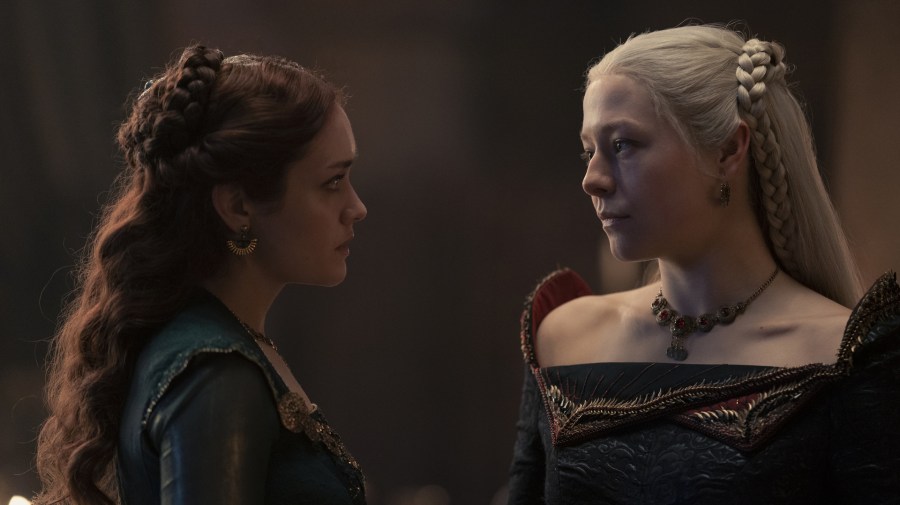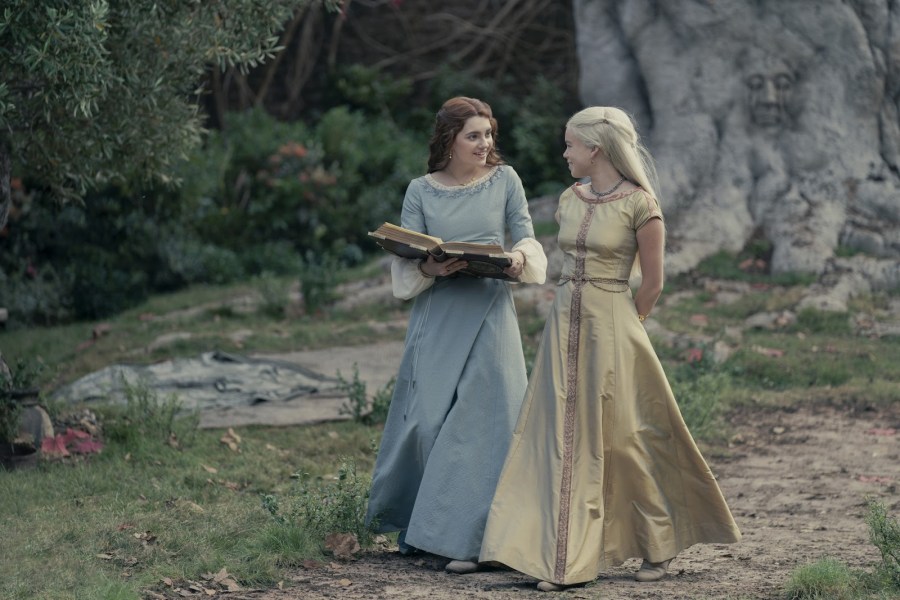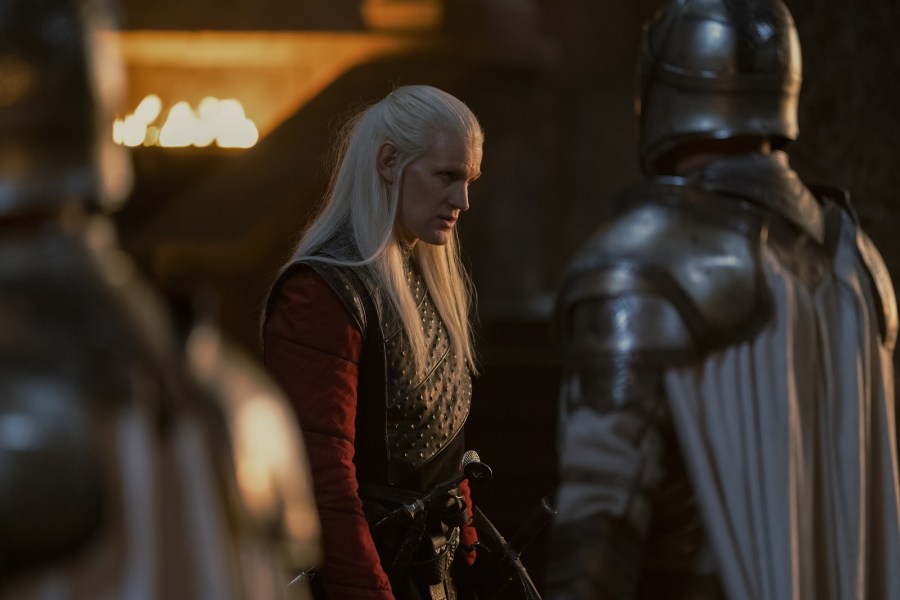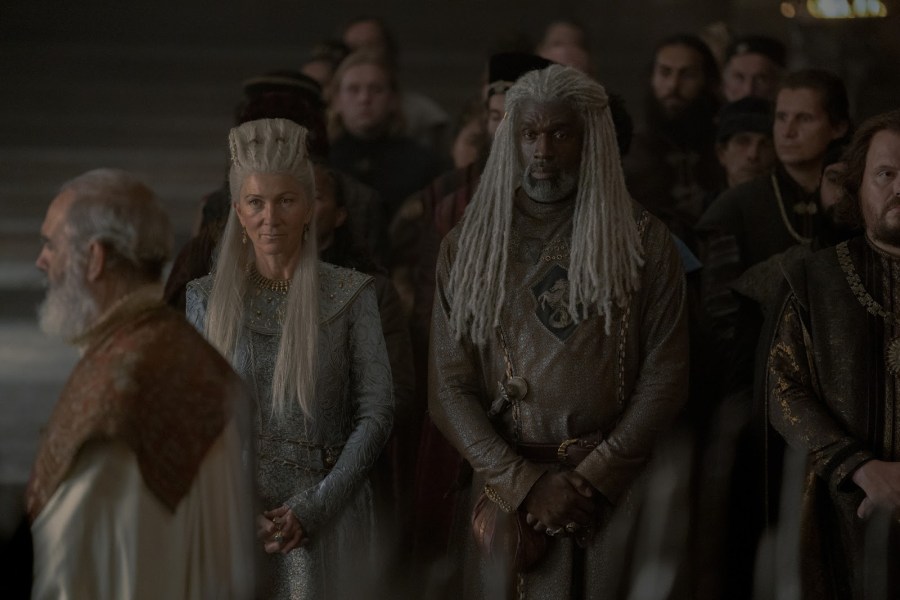
Rating: 8/10
I didn’t necessarily want to return to Westeros. Season eight of Game of Thrones (GoT) left a bitter aftertaste. Even if I was deeply addicted to its political intrigue, I wasn’t always a fan of HBO’s hit drama show — naked women were used almost as wallpaper, there was a lack of parity when it came to male nudity, and, frequently, sexual assault shaped major plot points. Plus, I simply profoundly disliked the way the show ended, especially when it came to the evolution of one of the show’s best characters until that point: Daenerys Targaryen (Emilia Clarke).
I approached House of the Dragon — the 10-episode prequel series debuting on HBO this Sunday, August 21 — with some skepticism. Having watched the six episodes available for review, I can say my reservations were unwarranted. The show was co-created by A Song of Ice and Fire writer George R. R. Martin and Ryan J. Condal. Condal and frequent GoT director Miguel Sapochnik serve as showrunners. House of the Dragon is based on Martin’s Fire & Blood book.
There’s something comforting and easy about heading back to a universe we know well by now. Even if House of the Dragon is set 172 years before Daenerys’ birth, not much has changed in Westeros. The Targaryens are in power though, and their dragons make them almost invincible. The only thing that could tear down the House of the Dragon is itself — or so we’re told.

King Viserys Targaryen (Paddy Considine) succeeds the previous Targaryen on the Iron Throne. But he has yet to father a viable male heir. Even though his teenage daughter Rhaenyra (Milly Alcock) can fly a dragon, achieve the surrender of a warrior adversary or savagely kill a wild boar, she’s still seen as just “a girl”.
“Men would sooner put the realm to the torch than see a woman ascend the Iron Throne,” Rhaenyra’s cousin Rhaenys (Eve Best) tells the young and ambitious princess. Rhaenys knows what she’s talking about. She was the oldest descendant of the previous Targaryen king and was passed over in favor of the oldest male descendant, Rhaenyra’s dad Viserys.
Of course, there are many suitors eager for the Throne — or aiming to control whoever reigns — but the main challenger to Rhaenyra’s claim is her uncle, Daemon Targaryen (Matt Smith). And once you get past the platinum blond wig, you can just enjoy Matt Smith relishing all of Daemon’s swagger and strangeness.
“You’re weak Viserys. And in that council of leeches, they all know it,” Daemon tells his brother. He means the small council and he isn’t wrong. Viserys does seem on the brink of death at every turn and his Hand and closest confidant, Otto Hightower, who’s played with calculated precision by Rhys Ifans, will stop at nothing to “guide” Viserys towards what he feels is reasonable. Otto will even go as far as employing his young daughter Alicent (Emily Carey) in the task.
It’s easy to return to Westeros this second time around — now that we already know what a Hand does or why Grand Maesters are essential, yet not quite advanced — even though we find it inhabited by a set of completely different characters. They still have so much in common with the characters in Game of Thrones.

Like its predecessor, House of the Dragon is a portrait of the thirst for power and the price one pays for it. “Being King is not easy. The Iron Throne is the most dangerous place on the ground,” Viserys warns his daughter Rhaenyra. “I’m forever doomed to anger one person while pleasing another,” he adds frustratedly at another point. And there are many references to the ceaseless sacrifices that should be made while being a monarch.
Rhaenyra’s mother, Aemma (Sian Brooke), explains to her daughter that the discomfort of pregnancy and labor is how women serve the realm. Even if Rhaenyra would prefer battle. The show makes a conscious point of showing how brutal the service of procreation can be in Westeros and how women were made to produce one heir after another to ensure the line of succession. There are three labor scenes in House of the Dragon, all with different outcomes. All of them are shown to be painful and risky. One of them is photographed through a top-down shot of the bed where Aemma lies in agony, the crisp white linen of the bed contrasting with her bright blood. It’s one of the most brutal scenes I’ve witnessed in a Game of Thrones property and it’s not like House of the Dragon shies away from violence when it comes to bloodied battlefields.
In its depiction of the duties attached to the Iron Throne, the show reminded me of The Crown. And it did so once again when, in episode six and after a 10-year ellipsis, House of the Dragon recasts the roles of Rhaenyra and Alicent and employs actors Emma D’Arcy and Olivia Cooke to play them respectively. And although Cooke seems a fitting replacement for a Cersei Lannister kind of character and D’Arcy just excels as a more mature and scheming Rhaenyra, I felt the absence of the younger actresses. Especially Milly Alcock as the younger Rhaenyra, who already had me rooting for her to become queen. She’s, of course, the Daenerys of this story.

I liked how the show handled certain themes. House of the Dragon is a more current and aware show than early GoT was when it comes to female characters and even some intimate scenes. There’s a particular love-making sequence that surprised me in its tenderness. We witness the laborious work involved in taking off zipperless garments and shoes.
This is still a Game of Thrones title though, there’s also plenty of background sex and nudity, often of the gratuitous kind. And a relationship between two closely related people with quite the age difference veered on creepy, if totally on brand.
There’s also the inclusion of a new Westerosi family with old roots in Valyria, the Velaryon, who are led by Lord Corlys (Steve Toussaint). Through them, the show introduces diversity early on. The Velaryons are Black and share the same silvered-tone hair as the Targaryens.
I’m eager to spend more time with Rhaenyra, Alicent, Daemon and the many new characters the writers devised for us in this return to well-known places. I welcomed the reappearance of King’s Landing, the Red Keep and Dragonstone. I liked being casually reminded about the Lannisters, the Baratheons, the Martells — to trust them is to be disappointed, we’re told. Yet I don’t remember it that way.
Watching House of the Dragon, I could easily spot where the money in producing the show has been spent — besides the lavish costumes and sets. There sure is a special allocation in the budget for silver wigs, fake blood and digital dragons.
Although I didn’t feel the urge to go back to Westeros at first, I enjoyed the dragon-filled way House of the Dragon transports us there. Even the show’s opening credits, while much shorter than the iconic Game of Thrones ones, adapt that show’s main theme and set the mood for more tales about power-thirsty would-be monarchs and their deceitful would-be acolytes.






